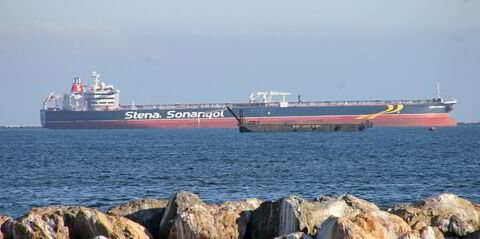A high-profile test of major energy efficiency improvements to four vessels managed by Hammonia Reederei has generated inconclusive results due to a lack of detailed performance data.
The retrofit aimed to prove that fuel consumption of 10-year-old, 10,536-dwt general cargoships could be cut by 25%, but data gathered in the first year of monitoring showed a definite fuel saving of only 7%, and potentially as high as 20%.
Work to reduce fuel usage was undertaken in early 2016 on the Industrial Ruby, the primary test vessel. This included propeller polishing, blasting and hull coating, a bulbous bow modification, and fitting a propeller/rudder bulb.
Overseen by environmental organisation Carbon War Room (CWR), the refit was part of a bold project to share fuel savings between the owner, the charterer, and the bank that financed the $1.2m refit.
Data from the experiment, which aimed to increase industry confidence in the profitability of retrofits, was independently analysed by the University College London (UCL)'s Energy Institute.
“Low frequency and quality associated with the dataset used means that the measurements can only prove — to a 95% confidence interval — that the saving was at least 7%, but could be up to 20%,” UCL said in a report seen by TradeWinds.
CWR finance lead manager for maritime James Mitchell says 20% fuel savings were observed at the ship’s average speed of 13.75 knots. This was based on an improvement of 14%, plus-or-minus a 6% level of uncertainty. Lower figures were reported at higher or lower speeds.
Mitchell adds that the fuel saving was sufficient to trigger the profit sharing clause between charterer Intermarine and the owner, which he says achieved “our primary driver in helping finance this retrofit as a model for shared savings projects”.
But variation between measurements taken from the Industrial Ruby meant that although performance could be estimated, UCL says normalisation for weather conditions and draught could not be. Speed and draught data were measured at five minute intervals, while weather and draught figures were only recorded once every 24 hours.
Noon report data had been collected for the ship since 2011, but continuous monitoring only started after the modifications were made in February 2016.
These factors resulted in a lack of comparable data to check performance before and after the retrofit.
But UCL says the results do show that better information would potentially allow the effects of energy efficiency interventions to be determined.
It says that the noon data showed the Industrial Ruby’s energy efficiency had deteriorated significantly before the modifications were made, and that the retrofit “returned the performance of the ship near to its original performance”.
“However, the data measured from the ship after the 2016 intervention was still underperforming relative to the performance quantifications” measured from sea trials after the ship’s launch.
UCL also says that monitoring offers greater insight into performance than that offered by modelling or tank testing.
It adds that relatively straightforward improvements in data gathering are possible and would help “to improve the understanding of performance benefits of retrofit packages, as well as improving the quality of information used as inputs to commercial/financial deals around retrofitting”.



